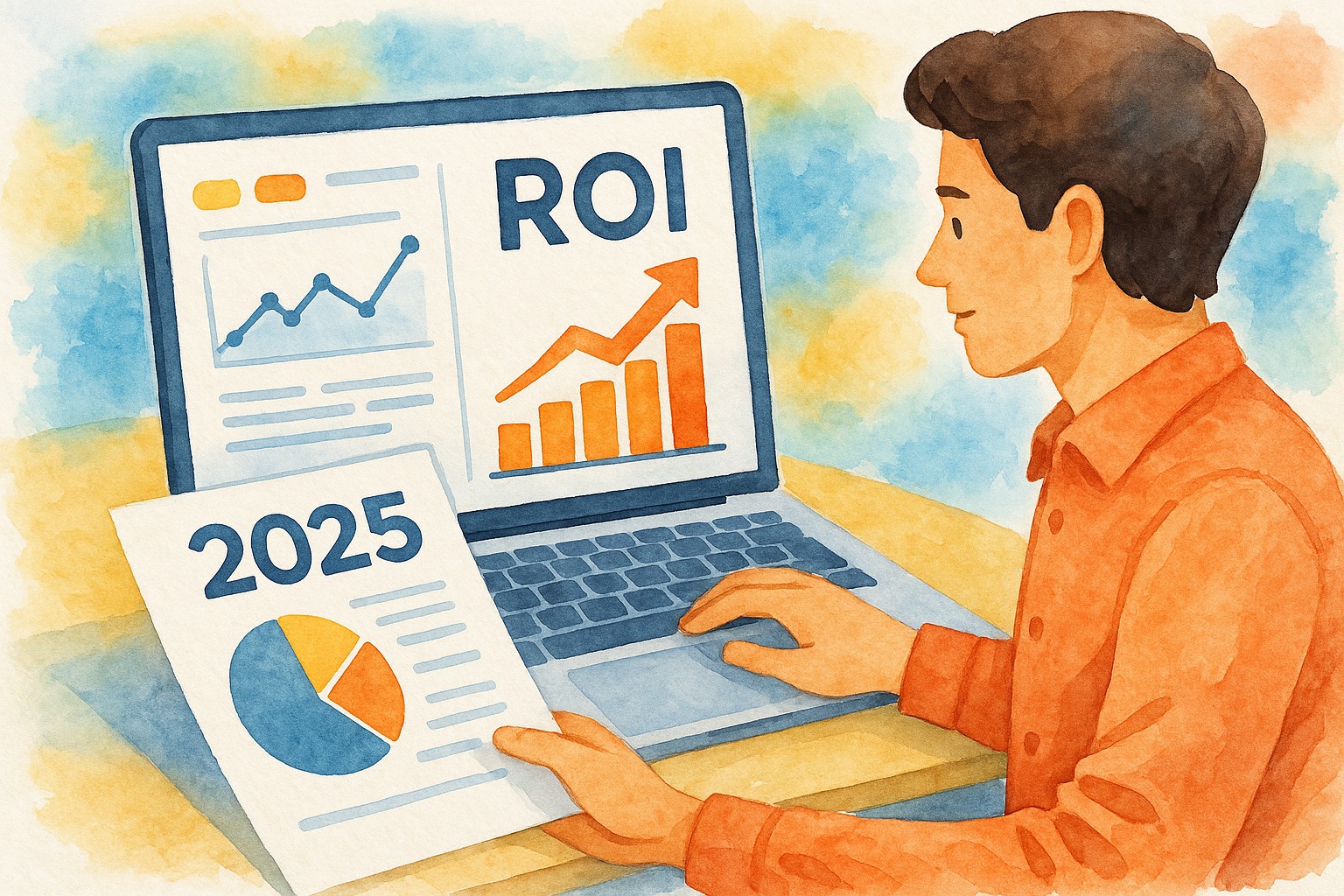If you’re a small business owner, you already know that every dollar spent on your website needs to make a difference. But between analytics dashboards, endless acronyms, and the ever-changing rules of digital marketing, actually measuring your website optimization ROI can feel overwhelming. Let’s break it down step by step, so you can see what’s working, what needs tweaking, and how to make your site bring in real results for your business in 2025.
How to Measure Website Optimization ROI for Small Business Owners in 2025
Understanding Website Optimization ROI
Website optimization ROI—Return on Investment—means figuring out whether the time, money, and resources you’re pouring into your website are actually driving business growth. This isn’t just about how your site looks, but how well it’s converting visitors into leads, sales, and long-term customers.
ROI for website optimization can be measured by comparing the benefits you gain (like increased sales or leads) to the costs you incur (like design, content, and marketing expenses). The formula is simple:
- ROI = (Net Profit from Website Optimization / Total Optimization Costs) x 100
However, while the formula is straightforward, the challenge is capturing the right data and interpreting it correctly. For small businesses, every improvement counts—especially as digital competition ramps up each year. For example, organic search contributes 37.5% of total revenue for e-commerce businesses. That means your website’s performance can be a huge lever for growth if you know how to measure it.
Understanding ROI isn’t just about tracking sales. It’s also about seeing improvements in brand awareness, local reach, and customer engagement. Optimizing your website goes beyond flashy design—it’s about creating a seamless user experience that encourages action.
Key Metrics to Track
To really understand your website optimization ROI, you need to focus on the metrics that matter. Here are the key numbers every small business owner should track:
- Traffic Sources: Know where your visitors are coming from—organic search, paid ads, social media, or referrals. This helps you focus your efforts where they pay off the most.
- Conversion Rate: How many visitors are taking action (buying, signing up, calling)? This is the heartbeat of website ROI. Sometimes, just tweaking a headline or call-to-action can make a huge difference. Remember, 47% of websites have a clear call-to-action button that takes users 3 seconds or less to see. Make sure you’re part of that group!
- Bounce Rate: This tells you the percentage of visitors who leave after viewing just one page. A high bounce rate means your content or design isn’t grabbing attention.
- Average Session Duration: How long are users spending on your site? Longer visits often mean more engagement and a higher chance of conversion.
- Pages Per Session: Are users exploring your site, or just landing and leaving? More pages per session generally indicate a more engaging experience.
- Lead Generation: How many new contacts or inquiries are you getting from your website? This is especially important for service-based businesses.
- Sales & Revenue: For e-commerce businesses, track actual sales and revenue generated through your website. For others, track offline sales influenced by online visits. 78% of mobile local searches result in an offline purchase within 24 hours, so don’t underestimate the power of your website to drive in-person business!
- Local SEO Performance: Since 46% of all Google searches are for local information, emphasizing the need for local SEO, track how often you show up in local searches and how many local visitors you’re attracting.
- Landing Page Performance: See which pages are converting best. Businesses with over 40 landing pages generate 12 times more leads than those with 1-5 landing pages, so expanding your landing page strategy could pay off big.
Set up a regular reporting schedule—monthly or quarterly—to monitor these numbers. It’s not about obsessing over every daily uptick, but about spotting trends that show your efforts are (or aren’t) working.
Tools and Techniques for Measurement
Measuring website optimization ROI doesn’t have to be complicated or expensive. There are a wealth of tools and methods—both free and paid—that make tracking your results manageable, even if you’re not a data expert.
- Google Analytics: The gold standard for tracking website traffic, user behavior, conversion funnels, and more. Set up Goals to track email signups, purchases, or contact form submissions.
- Google Search Console: See exactly how your site appears in search results, track search queries, clicks, impressions, and fix indexing issues. It’s essential for monitoring your SEO health.
- Heatmap Tools (like Hotjar or Crazy Egg): These show you where users are clicking, scrolling, or dropping off. This visual data can help you optimize layouts for better conversions.
- CRM and Marketing Automation Platforms: Tools like HubSpot or Mailchimp can help track leads from your website through to sale, making ROI calculations much easier.
- Call Tracking: If phone calls are important for your business, use unique tracking numbers to see which website pages or campaigns are driving calls.
- Split Testing (A/B Testing): Test changes to headlines, images, or buttons to see what actually increases conversions. Even small tweaks can have big results over time.
- Local SEO Tracking: Tools like Moz Local or BrightLocal help you monitor your local rankings and manage your business listings across directories. This is critical since 92% of consumers choose businesses on the first page of local search results.
Don’t overlook integrating your website data with your sales or point-of-sale systems where possible. This helps you see the full picture—from website visit to actual revenue—rather than just isolated web stats.
Finally, regularly benchmark your current performance against your past results and industry averages. This helps you identify what’s working and where there’s room for improvement.
Interpreting Data to Drive Decisions
With all this data at your fingertips, the real magic happens when you use it to make better business decisions. Here’s how you can turn raw numbers into actionable insights for your small business:
- Identify Bottlenecks: If your traffic is high but conversions are low, look for issues with your landing pages, forms, or calls-to-action. Maybe your offer isn’t clear enough, or your checkout process is too complicated.
- Double Down on What Works: If a particular blog post, product page, or ad campaign is bringing in lots of leads or sales, invest more in it. Consider creating similar content or promoting it further.
- Fix What’s Not Working: High bounce rates or low engagement on certain pages? Test new headlines, improve your images, or make your call-to-action more prominent.
- Measure Local Impact: Especially for local businesses, track how online visits translate into in-store visits or calls. Remember, small businesses investing in SEO see an average ROI of 400% within two years, so even incremental improvements can have a big payoff.
- Expand Landing Pages: The data shows that more landing pages mean more leads, so consider building additional pages tailored to specific services, products, or local areas.
It’s easy to get caught up in vanity metrics like “hits” or “followers.” Instead, focus on metrics that drive real business outcomes—sales, leads, and local visits. And don’t be afraid to experiment; the beauty of digital marketing is you can adjust quickly based on what the numbers tell you.
Case Studies: Small Business Success Stories
Let’s look at how real small businesses have cracked the code on website optimization ROI—just the kind of stories you’ll see featured on https://brenham.buzz.
- Local Bakery: A neighborhood bakery revamped its website with a mobile-friendly design and improved local SEO. Within six months, their site traffic doubled, and they started seeing a consistent stream of new customers walking in the door. They tracked calls and in-person orders prompted by online searches. As a result, “78% of mobile local searches result in an offline purchase within 24 hours.” Their investment paid for itself in record time.
- Home Services Company: After adding more landing pages targeting different service areas, a small plumbing company saw a 400% increase in online form submissions. This is right in line with the stat: “Businesses with over 40 landing pages generate 12 times more leads than those with 1-5 landing pages.” By tracking which pages brought in the most leads, they focused their marketing where it mattered most.
- Online Boutique: An e-commerce boutique used Google Analytics and split testing to refine their checkout process. By removing unnecessary steps and clarifying their call-to-action, their conversion rate jumped by 30%. As they grew their organic search traffic, they learned firsthand that “organic search contributes 37.5% of total revenue for e-commerce businesses.”
These stories prove that you don’t need a massive budget or a team of data scientists to see real ROI from your website. With the right focus on measurement and optimization, small businesses can punch well above their weight in the digital world.
Measuring your website optimization ROI might seem daunting at first, but with the right approach and a few smart tools, you’ll have clear answers—and a path to even greater success in 2025 and beyond.


Leave a Reply